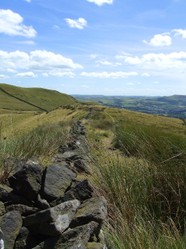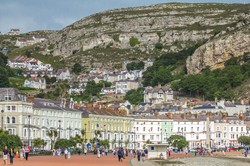Climate change predictions inform us that while south east Britain will suffer more drought, the north and west will be vulnerable to stormier conditions, and so it has come to pass.Storms seem to be getting worse and flooding is becoming more common.This is a challenge to the infrastructure, some of which was constructed in the 19th century. Several of our dams were erected at that time. The engineering was excellent, but we knew less then than we do now, and materials were not as sophisticates. Dams were constructed to meet the demands of the climate then, and we must ask whether or not some need upgrading. There is also the problem of inferior upgrades done at a later time.
Late July 2019 was hot, and that month had been Britain's hottest month ever. Days of heat across the East Atlantic caused evaporation of sea water into the warm air, but then a low pressure system took over, the air cooled and the water came down as torrential rain. Some parts of Northern England suffered minor flooding, though the dry ground soaked up the water, but the waters had done some damage to the Todd Brook Dam. All dams must have a supervising engineer and an inspection engineer, who must inspect regularly, and when the latter performed his inspection he discovered damage. Concrete slabs that constituted an outer casing on the dam had been forced loose and a hole was developing in the dam wall. The Canals and Rivers Trust, who own all dams in England and Wales, were alerted, as were the police,and the emergency procedure was instituted
The town of Whaley Bridge is in a narrow valley with steeply sloping hills on both sides. It is centred on the river Goyt, though the dam, which is a small one, was constructed in 1831 as a reservoir to feed the Peak Forest Canal at a time when canals were a major artery for commercial goods. Since then its industrial use has faded, but it has become a leisure resource for local people and a site of special scientific interest. But if the dam collapsed a mass of water would deluge the pleasant little town and massacre many of those dwelling in the narrow valley bottom, before surging down the Goyt, thence to the Tame, a river in a heavily populated area, then down to the Mersey that flows through South Manchester [ a mile from my house!] and to the Irish Sea.The most damaging flooding would be local, but it could involve great loss of life and severe destruction.
Engineers believed that the dam was in imminent danger of collapse and so the police advised local people to evacuate immediately. Some went to evacuation centres,others to friends and relatives. A few refused to move. Then the work to make the structure safe began with urgency.







 TheThousand Year Gardenon 11/26/2025
TheThousand Year Gardenon 11/26/2025
 Women of the Gospelson 10/11/2025
Women of the Gospelson 10/11/2025
 Religious Gardenson 08/25/2025
Religious Gardenson 08/25/2025
 Doctor of the Church: John Henry Newmanon 08/03/2025
Doctor of the Church: John Henry Newmanon 08/03/2025




Comments
We are getting our vegetables late as you are.
Thank you for your comment in answer to my previous observation and question.
Mosses in particular enchant me. The yard west of the southwest- to northeast-running driveway has a "forest-floor" look. Lichen on the trees and moss on the ground with bare soil, berries, heaved maple roots, mushrooms, pine and yew needles, sporadic non-turf grass and unexpected plants make up that "forest-floor" look for me.
But yesterday -- not occurring as early as March to May -- I finally observed my first -- not the usual many -- mushroom. This year offered lightning bugs in mid-May (not the standard last weekend of April) along with the tiniest strawberries occurring separate from, not with, wild onion.
Might fireflies, mushrooms, wild onions and strawberries be showing unexpectedly late -- or not at all -- this year in the British Isles?
Brambleberries, raspberries and wineberries ripened early June even as wineberries never ripened at all. The latter shows beautiful leaves without their tasty fruit ;-{.
Though rare, science knew of them. There were no species unknown to science
The third-last paragraph advises us of area rare liverworts and mosses.
Are such area plants already analyzed and researched or are there losses to scientific knowledge?
My daughter in law's family are from that area and she has uncle s and cousins there. But their part of Whaley Bridge was unaffected. The emergency services did a sterling job. They were tireless and superb .
As the dam is twenty two miles away from my house there would have been few, if any, ill-effects,though the Mersey, a mile away from where I live, would have swelled with floodwater. But the Mersey flood defences are excellent.
I sometimes travel on the closed railway line, but not at this time of the year, and, anyway, I have recently retired from the job for whose work I travelled that route.
So I was not affected at all.
As important as dams are, they restructure nature. The water would have moved along its natural course if unimpeded. Perhaps at too great of a flow, but not threatening a catastrophic failure all at once.
In ancient times mankind was nomadic, and would move away from a flooding river, so all would have been well. With structures this is not the case.
I hope you were not personally affected.
I do not know whether they were able to check for water bars, as the checking may have involved taking up the concrete.
The residents who did not want to leave stayed there, but any who left the forbidden area would not have been allowed back.
frankbeswick, Thank you for the practical information, the product lines and the updated prognosis below.
Did the previous inspection not have a way of checking whether water bars were present? What was done about the Whaley Bridge residents who did not want to leave?
Water level targets have now been reached. The dam should be safe!